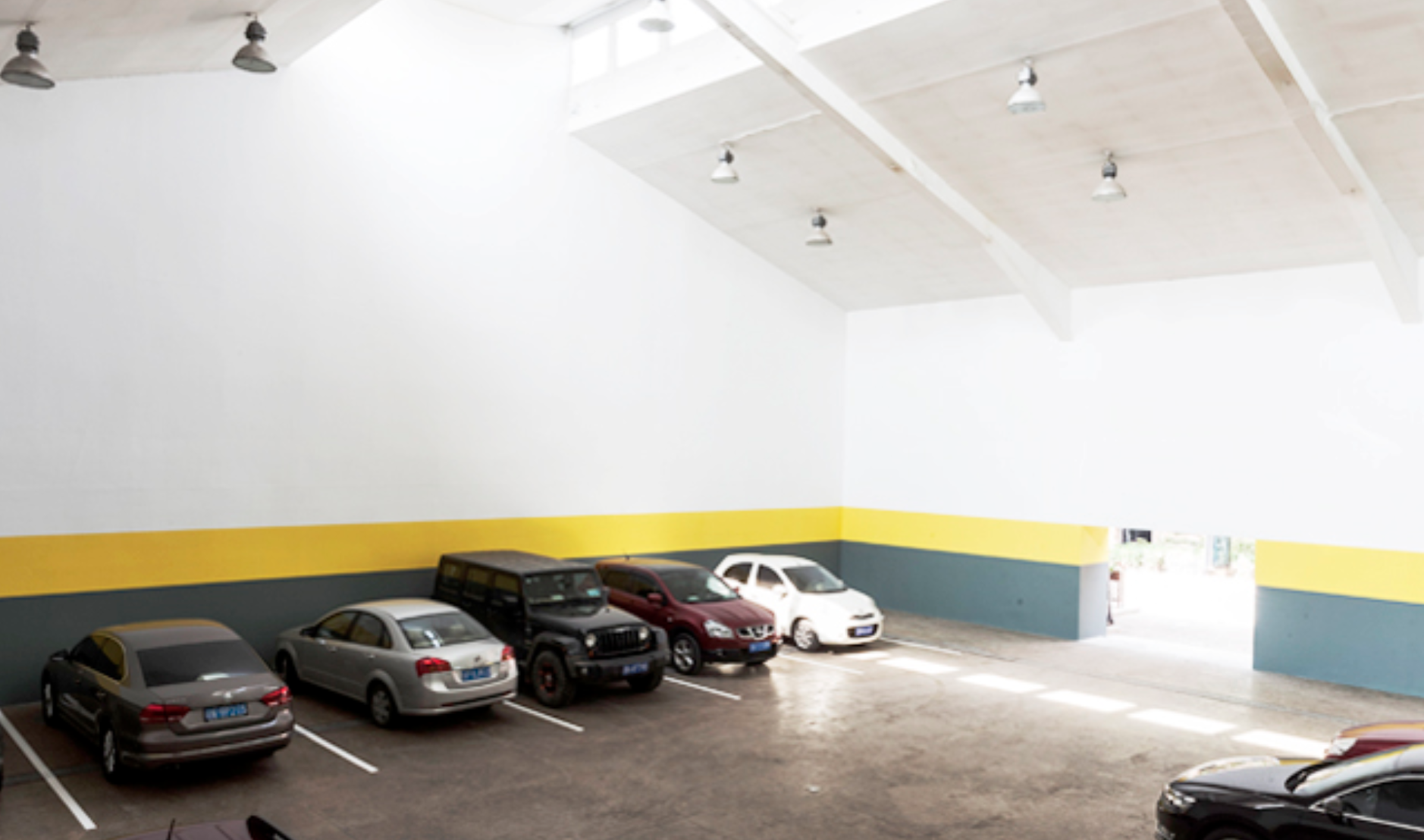林明弘:空位 Michael Lin: Place Libre

林明弘个展《空位》现场(图片由当代唐人艺术中心提供)
在你把车开进来之前,当代唐人艺术中心的主展厅里什么也没有。如果严格的说,这里只有地面上的十条白线,和墙壁上黄色和灰色两道涂层,仅此而己。事实上,仅仅凭借这些明确而简单的线条,空间的属性就已经开始发生戏剧性的变化。面廊原有的面貌消蚀地不可辦认,而这里的环境显然是一个停车场。这正是林明弘在最新个展“空位”中所精心营造的。
林明弘对画廊的空间千预非常彻底,也极为巧妙。他没有在展厅 里放置任何艺术品,而是在地面上用线条规划出了八个标准尺寸的停车位,在面廊门口安装了一个普通的蓝色停车指示牌,并在展厅角落处用音箱实时播放着北京当地司机喜欢收听的广播节目。与那些布展工程日益变得复杂的当代艺术展相比,林明弘的布展实在显得极度简洁,但它的效果却非常显著:画廊的视觉面貌和实际功能都发生了有趣的变化,展览空间蜕变成为了名副其实的停车场。前来展览的观众们则可以将自己的汽车从室外一路开进展厅并停泊在这里,也可以在空间中随意走动或彼此交谈。
除了对物理空问千预,这个展览令人兴奋之处也在于重新定义了观众和展览之间的关系,进而创造出一个社交空间。在当代艺术里,观众总是期待能够在展览里看到新奇的景观,观众也对展览充满了各式的想象。不过,这些期待和想象在这个停车场里被完全地颠覆了。因为这里没有什么是需要定睛观看的。人们在这里也并不再扮演被动的观看者的角色,他们的身份转变成了这项艺木计划的参与者。就像前文提及的,这里其实什么也没有,因此人们的一举一动就成为了这项计划的组成部分。在这个意义上,观众成为了参与者,甚至与艺术家一起成为了展览的共同制造者。与此同时,这里集合了各种各样的人际活动,包括开车、停车、走动、交谈等等,这些活动在不断累积,并最终在停车场之中形成为一个社交空间。
林明弘针对空间的实践由来已久。他曾将合湾本土特色的织布图案应用在不同的空问之中,如美术馆墙壁或网球场的地面;去年他的“样板屋〞计划关注了上海当地建筑工人的居住环境,并在美术馆中搭建出了工棚。在此次个展中,林明弘的空问干预带来了更加复杂的效果,画廊、停车场、社交空问三种空间香加在一起而生产出了一种新的空间混合物。它不但挑战了面廊作为商业空间的经济属性,也消除了“白盒子”式的展览形式,而且它还带来了更多的话语。
林明弘个展“空位”将在北京当代唐人艺术中心展出至10月30日。
There is nothing else in the Tang Contemporary Art exhibition hall, strictly speaking, there are 10 white lines on the floor and one yellow and one grey stripe painted on the wall. With these clear and simple lines, the nature of the space have already undergone a dramatic change. The original appearance of the gallery has given way to reveal a parking lot, painstakingly planned by artist Michael Lin for his new solo show “Place Libre.”
Lin’s intervention in the gallery space is simple yet clever. He has not placed any artworks in the space; instead, he painted lines on the floor to demarcate 8 standard parking spots. A normal blue parking sign was placed at the gallery entrance, and loudspeakers positioned in the corners of the exhibition space play popular radio programs enjoyed by Beijing drivers. Compared with the increasingly complicated installation processes of many contemporary art exhibitions, Lin’s is extremely simple, but the effect is powerful. With these few lines of paint, the gallery’s visual appearance and actual function changed, from an exhibition space to an actual parking lot into which viewers can bring in their cars.
In addition to the intervention in the physical space, this exhibition also redefines the relationship between the viewer and the exhibition, thereby creating a social space. The viewer always expects something new and different at a contemporary art exhibition, imagining the possibilities the show could offer. However, these expectations and imaginations are completely subverted by the parking lot. Not only is there nothing specific to view, but the parking lot is not new and different; it is part of everyday experience. Here, people no longer play the role of passive viewers; they are transformed into participants. There is nothing in the space, so everyone’s actions become part of the project. In this sense, the viewer becomes a creator together with the artist. The gallery space as a parking lot is a site of human activity, where people drive, park, walk, and chat. These activities continue to accumulate, creating a social space in the parking lot.
Michael Lin’s practice often involves spatial interventions. He has applied Taiwanese textile patterns to different spaces, such as museum walls or tennis court floors. Last year, his “Model Home: A Proposition by Michael Lin” project at the Rockbund Art Museum focused on the living environments of Shanghai construction workers, for which he built a dormitory in the museum space, coupled with the work of musicians, other artists, and architects. In “Place Libre,” Lin’s spatial intervention had a much more complicated effect than his previous work. Using the new hybrid space produced by the intersection of gallery, parking lot, and social space, he challenges the economic properties of the gallery as a commercial space and eliminates “white box” exhibition methods, but he is still left with plenty to say.
本文发表于BLOUIN ARTINFO
出版日期:2010年10月11日
作者:王懿泉
本文谈及的展览信息:
展览:《林明弘:空位》
展厅:当代唐人艺术中心
地址:北京市朝阳区大山子酒仙桥路2号798艺术区D区06栋
展期:2013.9.14 - 2013.10.30
This article was written in Chinese and translated into English by Bridget Noetzel.

林明弘个展《空位》现场(图片由当代唐人艺术中心提供)
在你把车开进来之前,当代唐人艺术中心的主展厅里什么也没有。如果严格的说,这里只有地面上的十条白线,和墙壁上黄色和灰色两道涂层,仅此而己。事实上,仅仅凭借这些明确而简单的线条,空间的属性就已经开始发生戏剧性的变化。面廊原有的面貌消蚀地不可辦认,而这里的环境显然是一个停车场。这正是林明弘在最新个展“空位”中所精心营造的。
林明弘对画廊的空间千预非常彻底,也极为巧妙。他没有在展厅 里放置任何艺术品,而是在地面上用线条规划出了八个标准尺寸的停车位,在面廊门口安装了一个普通的蓝色停车指示牌,并在展厅角落处用音箱实时播放着北京当地司机喜欢收听的广播节目。与那些布展工程日益变得复杂的当代艺术展相比,林明弘的布展实在显得极度简洁,但它的效果却非常显著:画廊的视觉面貌和实际功能都发生了有趣的变化,展览空间蜕变成为了名副其实的停车场。前来展览的观众们则可以将自己的汽车从室外一路开进展厅并停泊在这里,也可以在空间中随意走动或彼此交谈。
除了对物理空问千预,这个展览令人兴奋之处也在于重新定义了观众和展览之间的关系,进而创造出一个社交空间。在当代艺术里,观众总是期待能够在展览里看到新奇的景观,观众也对展览充满了各式的想象。不过,这些期待和想象在这个停车场里被完全地颠覆了。因为这里没有什么是需要定睛观看的。人们在这里也并不再扮演被动的观看者的角色,他们的身份转变成了这项艺木计划的参与者。就像前文提及的,这里其实什么也没有,因此人们的一举一动就成为了这项计划的组成部分。在这个意义上,观众成为了参与者,甚至与艺术家一起成为了展览的共同制造者。与此同时,这里集合了各种各样的人际活动,包括开车、停车、走动、交谈等等,这些活动在不断累积,并最终在停车场之中形成为一个社交空间。
林明弘针对空间的实践由来已久。他曾将合湾本土特色的织布图案应用在不同的空问之中,如美术馆墙壁或网球场的地面;去年他的“样板屋〞计划关注了上海当地建筑工人的居住环境,并在美术馆中搭建出了工棚。在此次个展中,林明弘的空问干预带来了更加复杂的效果,画廊、停车场、社交空问三种空间香加在一起而生产出了一种新的空间混合物。它不但挑战了面廊作为商业空间的经济属性,也消除了“白盒子”式的展览形式,而且它还带来了更多的话语。
林明弘个展“空位”将在北京当代唐人艺术中心展出至10月30日。
There is nothing else in the Tang Contemporary Art exhibition hall, strictly speaking, there are 10 white lines on the floor and one yellow and one grey stripe painted on the wall. With these clear and simple lines, the nature of the space have already undergone a dramatic change. The original appearance of the gallery has given way to reveal a parking lot, painstakingly planned by artist Michael Lin for his new solo show “Place Libre.”
Lin’s intervention in the gallery space is simple yet clever. He has not placed any artworks in the space; instead, he painted lines on the floor to demarcate 8 standard parking spots. A normal blue parking sign was placed at the gallery entrance, and loudspeakers positioned in the corners of the exhibition space play popular radio programs enjoyed by Beijing drivers. Compared with the increasingly complicated installation processes of many contemporary art exhibitions, Lin’s is extremely simple, but the effect is powerful. With these few lines of paint, the gallery’s visual appearance and actual function changed, from an exhibition space to an actual parking lot into which viewers can bring in their cars.
In addition to the intervention in the physical space, this exhibition also redefines the relationship between the viewer and the exhibition, thereby creating a social space. The viewer always expects something new and different at a contemporary art exhibition, imagining the possibilities the show could offer. However, these expectations and imaginations are completely subverted by the parking lot. Not only is there nothing specific to view, but the parking lot is not new and different; it is part of everyday experience. Here, people no longer play the role of passive viewers; they are transformed into participants. There is nothing in the space, so everyone’s actions become part of the project. In this sense, the viewer becomes a creator together with the artist. The gallery space as a parking lot is a site of human activity, where people drive, park, walk, and chat. These activities continue to accumulate, creating a social space in the parking lot.
Michael Lin’s practice often involves spatial interventions. He has applied Taiwanese textile patterns to different spaces, such as museum walls or tennis court floors. Last year, his “Model Home: A Proposition by Michael Lin” project at the Rockbund Art Museum focused on the living environments of Shanghai construction workers, for which he built a dormitory in the museum space, coupled with the work of musicians, other artists, and architects. In “Place Libre,” Lin’s spatial intervention had a much more complicated effect than his previous work. Using the new hybrid space produced by the intersection of gallery, parking lot, and social space, he challenges the economic properties of the gallery as a commercial space and eliminates “white box” exhibition methods, but he is still left with plenty to say.
本文发表于BLOUIN ARTINFO
出版日期:2010年10月11日
作者:王懿泉
本文谈及的展览信息:
展览:《林明弘:空位》
展厅:当代唐人艺术中心
地址:北京市朝阳区大山子酒仙桥路2号798艺术区D区06栋
展期:2013.9.14 - 2013.10.30
This article was written in Chinese and translated into English by Bridget Noetzel.
